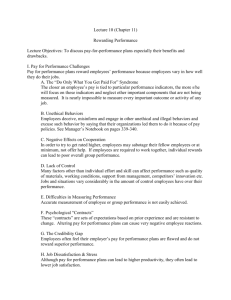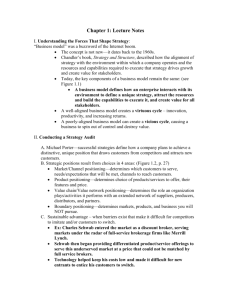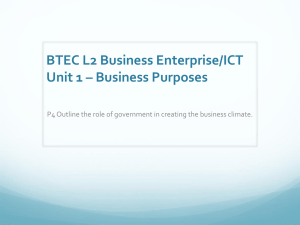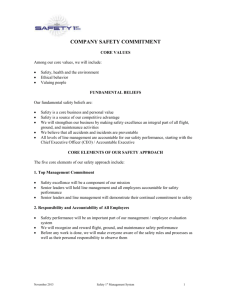Chapter 2
advertisement
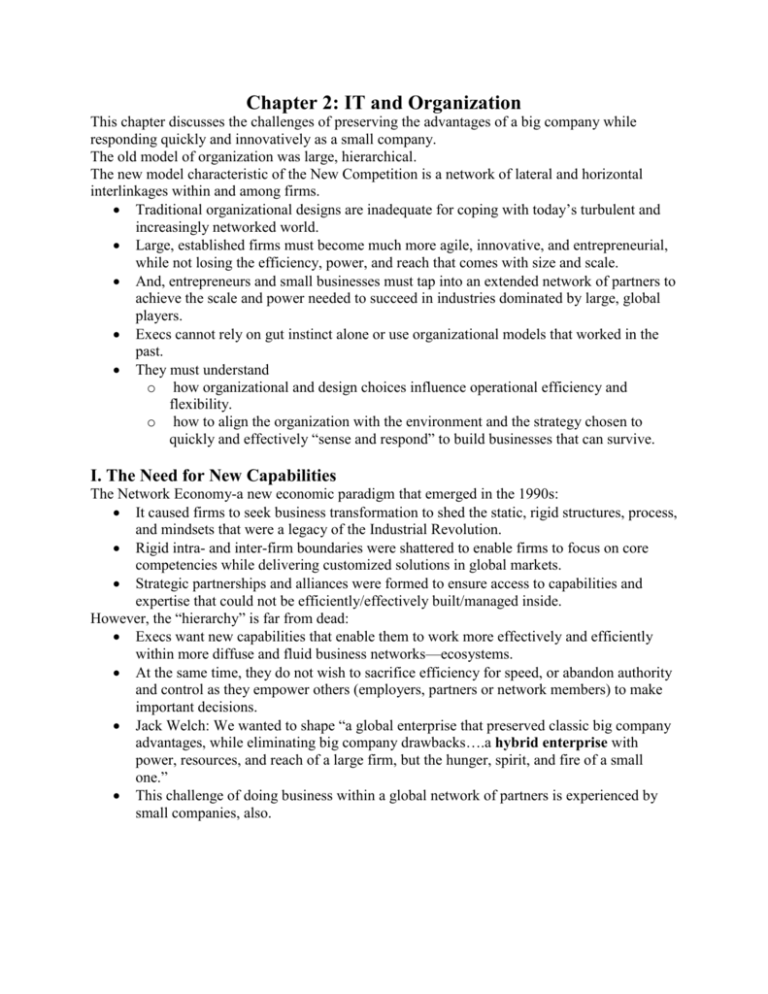
Chapter 2: IT and Organization This chapter discusses the challenges of preserving the advantages of a big company while responding quickly and innovatively as a small company. The old model of organization was large, hierarchical. The new model characteristic of the New Competition is a network of lateral and horizontal interlinkages within and among firms. Traditional organizational designs are inadequate for coping with today’s turbulent and increasingly networked world. Large, established firms must become much more agile, innovative, and entrepreneurial, while not losing the efficiency, power, and reach that comes with size and scale. And, entrepreneurs and small businesses must tap into an extended network of partners to achieve the scale and power needed to succeed in industries dominated by large, global players. Execs cannot rely on gut instinct alone or use organizational models that worked in the past. They must understand o how organizational and design choices influence operational efficiency and flexibility. o how to align the organization with the environment and the strategy chosen to quickly and effectively “sense and respond” to build businesses that can survive. I. The Need for New Capabilities The Network Economy-a new economic paradigm that emerged in the 1990s: It caused firms to seek business transformation to shed the static, rigid structures, process, and mindsets that were a legacy of the Industrial Revolution. Rigid intra- and inter-firm boundaries were shattered to enable firms to focus on core competencies while delivering customized solutions in global markets. Strategic partnerships and alliances were formed to ensure access to capabilities and expertise that could not be efficiently/effectively built/managed inside. However, the “hierarchy” is far from dead: Execs want new capabilities that enable them to work more effectively and efficiently within more diffuse and fluid business networks—ecosystems. At the same time, they do not wish to sacrifice efficiency for speed, or abandon authority and control as they empower others (employers, partners or network members) to make important decisions. Jack Welch: We wanted to shape “a global enterprise that preserved classic big company advantages, while eliminating big company drawbacks….a hybrid enterprise with power, resources, and reach of a large firm, but the hunger, spirit, and fire of a small one.” This challenge of doing business within a global network of partners is experienced by small companies, also. The “hybrid enterprise” concept described above was actually first implemented in the 1950s and 1960s—example, the matrix The matrix was billed as the solution to the need for control and efficiency, while at the same time, enabling flexibility and speed of response--an adaptive, information-intensive, team-based, collaborative, and empowered organization. However, companies that adopted hybrid designs like the matrix found that the new structure/systems created conflict, confusion, information overload, and cost duplication of resources. Why? Their companies were organizationally incapable of carrying out the sophisticated strategies they developed. A. Is History Repeating Itself? Why did the matrix concept fail? Companies were not able to handle the increase in the need for timely information to manage it successfully. Paper-based and word-of-mouth information moved slowly and channels of communication were limited. Mainframes were designed to support centralized decision making and hierarchical communication. Microcomputers eventually decentralized information processing, but local and enterprise-wide information sharing and communication remained inadequate. Beginning in the 1980s, the networked IT revolution has made possible new approaches to communicating and sharing information that redefine organizational possibilities. IBM’s “Business on Demand” concept—an enterprise that “unites information, processes, and people to create a enterprise in which end-to-end processes are integrated across a company/industry/globally, so that it can respond with speed/flexibility to customer demands, market opportunities, or external threats.” To act big and small simultaneously, technology is not enough. New approaches to organizing and managing are also required. B. Learning from Mistakes Organizational hierarchy specifies structures and systems that help safeguard a large firm from disasters. Authority systems limit decision making and actions by strict segregation of responsibility and duties, standardization of jobs, direct supervision, and restricted access to information and assets everywhere but the very top of the firm. Short of sabotage, no single employee of work unit should be able to make a decision or take an action that immediately threatens the entire organization. o Action controls-at the operational level, employees are told exactly what they are supposed to do and supervisors watch to see that they do it. o Results controls—at the managerial level, evaluation and compensation of managers based on their ability to meet predefined performance criteria. These controls help focus managerial attention/actions on organizational priorities and ensure coordination of actions and decisions across functional boundaries. o Personnel controls – ensure that the right people with the right skills are recruited, hired, developed, motivated, and retained. o Transaction controls—ensure risk and asset management through accurate, complete documentation of financial/legal transactions with regular review by senior execs, boards, and external auditors. Current buzzwords encourage execs to empower their people, expand their areas of responsibility, wipe out middle management ranks, and create self-managing teams. However, they do not specify how control and authority are to be maintained once the traditional systems have been disrupted. Three important lessons for designing organizations with the sense and respond capabilities needed in today’s fast-paced/complex/volatile business environment: Speed Counts, but Not at the Expense of Control—The faster the pace of business, the greater the need to monitor business operations and clearly define and enforce rules. Empowerment Is Not Anarchy— o Execs define empowerment as pushing decision making down the line or bypassing management. o They find difficulty in describing exactly who will make what decisions. o They often fail to recognize that decisions concerning who has authority and accountability to make a decision take action, or commit resources are tightly linked to a complex set of organization design features: -Structure—how people are grouped into units and how those units coordinate activities to develop and deliver products and services to customers. -Reporting relationships and power, both informal and formal -Incentives and performance management—compensation, evaluation, and measurement systems o In an empowered organization, senior execs must be more involved not less; and organizational boundaries and value systems must be more clearly communicated, closely monitored, and consistently enforced. Transforming an Organization Requires More Than Just changing the Structure o A comprehensive approach to organization design must include analysis/realignment of capabilities in five key areas: processes, people and partners, organization and culture, infrastructure, and leadership and governance. II. Information, Organization, and Control “Every aspect of organizational functioning depends on information processing of one form or another.” Since organizations are information processing systems, limitations in vertical/horizontal info processing capacity directly influences the range of organizational choices available to managers as they attempt to execute strategy. The ability to align/adapt an organization’s strategy and capabilities to the demands of a turbulent business environment is essential for building a high-performance organization. Execs have faced two key organizational challenges as they attempt to design organizations and build the capabilities that will enable them to survive in the volatile, complex, networked environment: 1) organizing for innovation and execution and 2) organizing for accountability and collaboration. A. Organizing for Innovation and Execution Many execs make changes to portions of their operations without considering the impact on other parts of the organizations, partners, suppliers, customers. Two common mistakes: Failure to redesign end-to-end processes. Ex: A consumer products firm accelerated new product development, but manufacturing and logistics were not in on the decision, nor were they informed in a timely enough manner to adjust supply and production schedules. Failure to realign operations with other components of the organization design (organization structure, control, authority systems, incentives, culture). Ex: In the same firm mentioned above, since the newly streamlined, integrated processes were not aligned with control, authority systems, etc., the real-time business intelligence and early warning systems needed to make decisions and take actions in the faster time frames were not in place. This same company learned several important lessons: We needed to recast our vision for change as an enterprisewide initiative rather than just a change within a specific function. As we sped up our processes, we needed to provide much more timely information to the people on the line who had to respond more quickly within a much more complicated, less structured role. We needed to bring functional managers together as teams—area operating teams-and provide them with the authority and accountability to coordinate and control these end-toend processes. Streamlining the operating and management process (see Fig. 2.3, p. 66) The business cycle is composed of two types of processes: o Operating processes—the activities through which an organization designs, produces, markets, delivers, and supports its products or services. o Management processes—the activities through which an organization manages the design, production, marketing, delivery, and supports of its products or services. Many companies attempt to streamline the business cycle by streamlining operating processes without a corresponding streamlining of management processes. The key is to streamline, integrate, and time synchronize both operation and management processes. Redefining Control Systems: Traditional hierarchy focuses on standardization of jobs and direct supervision—a compliance model of control. The emerging organizational model for a fast-cycled, more complex, global network economy requires a learning model of control that preserves flexibility and fosters commitment. Systems thinking—the ability to see a situation of problem in its totality—is at the heart of learning. It demands an understanding of the causal relationships between individual components of a system and the whole, and linking of causal relationships to the performance of the system in accomplishing goals. A learning model of control is based on a deep understanding of core operating processes. However, instead of segregating these processes, execs now seek to integrate and continuously improve them. The learning model of control in action: Streamlined, synchronized processes must be managed by teams that include membership that reflects the activities involved in the end-to-end process. Management teams must be close to the action and have access to relevant, timely information. They must e able to meet to debate the meaning of the information and to adjust tactical strategies and actions based on a timely review of business performance. They must be able to relate local business outcomes to the decision and actions they have taken and to enterprisewide priorities and performance. In other words, the learning model of control: Supports an active approach to problem-finding and a deep understanding of system dynamics. Demands that performance management and incentive system foster a commitment to shared goals and a shared understanding of how to achieve them. Is information–intensive and requires that managers become information literate. B. Organizing for Accountability and Collaboration Traditional distribution of authority within an organization: It was viewed as a trade-off between centralization and decentralization. Organizations were considered networks of relationships among “principles” (owners and senior execs) and self-interested “agents,” who, according to Agency Theory, do not necessarily share the principles’ goals and interests. With this approach, the importance of tight, top-down controls is easy to justify. The cost/risk of coordinating local operations and aligning individual interests was minimized by centralizing decision making, structuring operations, and developing a deep hierarchy so that operations were executed efficiently and according to clearlydefined procedures. Assumptions made: centrally located execs had the information needed to understand local business dynamics and the time/expertise to analyze the information to make wise decisions. As complexity, uncertainty, and volatility increased in the business environment, Many execs decentralized decision making to increasingly more focused, autonomous profit centers—favoring speed and responsiveness over centralized authority. Problem: decentralization increased cost of coordination and control as staff needed to collect, synthesize, interpret, and distill information. Results: o “the tyranny of control” –controllers were added in all business units, resulting in “checkers checking the checkers.” o As competition and price erosion increased, these slow-to-respond, costly authority structures became a drag on innovation and earnings. o Local managers were still held accountable for results, but so were group executives. “When everyone is accountable, no one is accountable.” Rethinking the Nature of Authority: It can no longer be viewed as a simple, linear trade-off between individual authority and collaboration. Managers must clearly identify authority and accountability, and execs accountable for various activities within an integrated process must get together to analyze timely, relevant info on process performance and results. Executive teams should share accountability for end-to-end process performance. Teams must ensure that effective decisions can be made and executed. They represent checks and balances that guard against organizational failure when employers are empowered with broad authority and accountability. Incentives o Shared incentives (team-based incentives and employee stock ownership plans) augment and reinforce shared authority and help align individual, team, and organizational priorities. o Performance evaluations and incentives must also recognize performance against individual goals. o Stretch targets help intensify effort, clarify priorities, focus attention, and support a commitment to collaborate among independent divisions. Authority for operating strategy development and its execution is moving from corporate headquarters to the field. o Interfunctional operating teams are inserted into the middle of the firm and granted broad authority for defining operating strategy and the processes, systems, and organizational arrangements to carry out and manage it. o They are held accountable for profitability, stakeholder satisfaction, operating process design, and continuous improvement. o They coordinate their businesses (inside and outside their organizational boundaries) using face-to-face and IT-enabled info sharing, networked communication, and ad hoc adjustment. o Work teams are formed at the line and given more authority for defining work and how to carry it out.



